Dissertation Proposal: Physician/APN Role in Diabetes Care, Riyadh
VerifiedAdded on 2023/04/22
|21
|6370
|303
Dissertation
AI Summary
This dissertation proposal investigates the comparative effectiveness of physicians and advanced nurse practitioners (APNs) in managing diabetes within a primary healthcare setting in Riyadh, Saudi Arabia. The research aims to evaluate the influence of each role on patient outcomes, specifically focusing on glycemic control, blood pressure, and cholesterol levels. The proposal includes a comprehensive literature review, outlining the current understanding of diabetes management, the challenges in primary care, and the potential of APNs in addressing these issues. It also presents a research methodology, including a retrospective chart review, to compare the outcomes achieved by physicians and APNs. The study hypothesizes that APNs are well-equipped to improve patient outcomes and proposes recommendations for integrating APNs into primary care settings. The proposal also includes a dissertation outline, detailing the structure and content of the complete dissertation, including chapters on introduction, literature review, research methodology, results, discussion, conclusion, and recommendations.
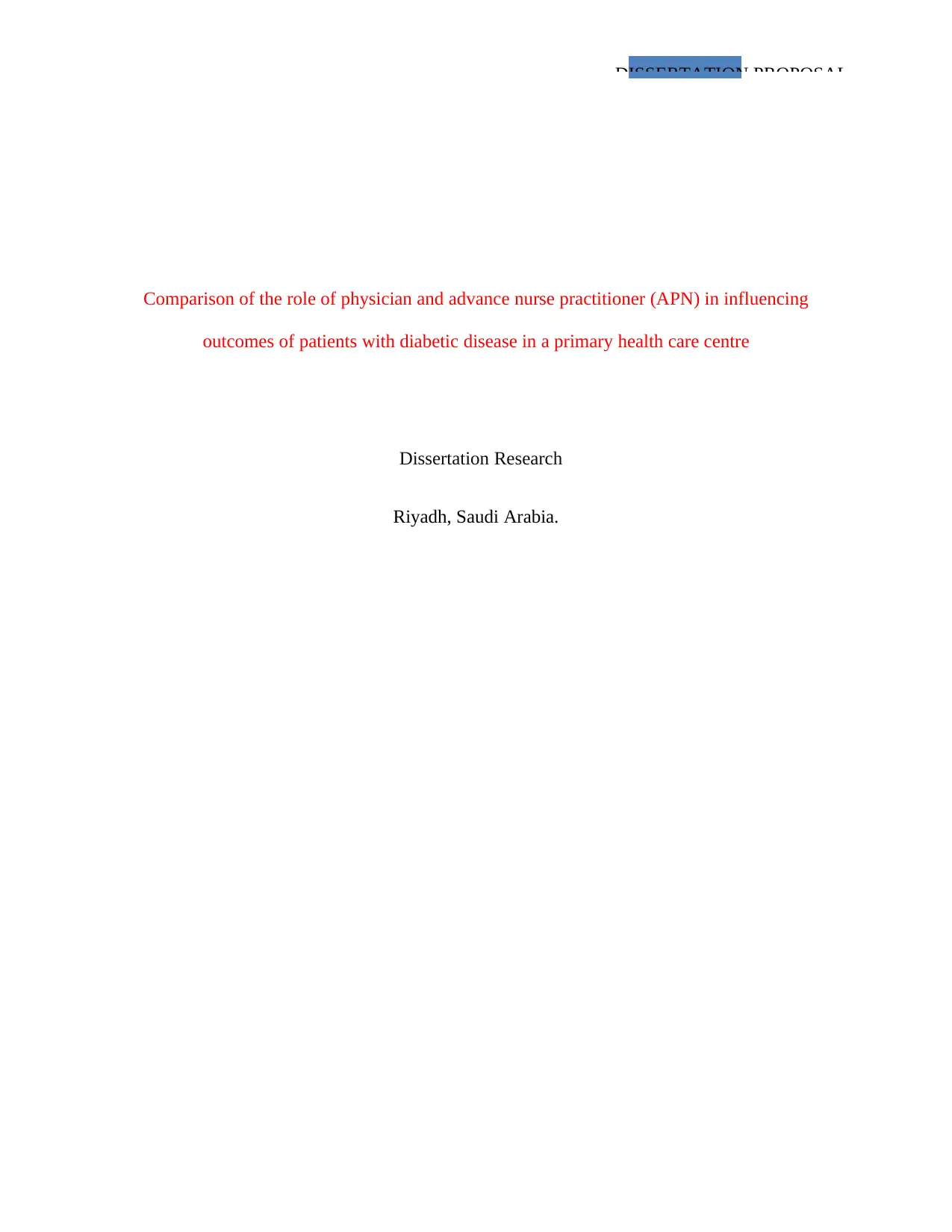
DISSERTATION PROPOSAL
Comparison of the role of physician and advance nurse practitioner (APN) in influencing
outcomes of patients with diabetic disease in a primary health care centre
Dissertation Research
Riyadh, Saudi Arabia.
Comparison of the role of physician and advance nurse practitioner (APN) in influencing
outcomes of patients with diabetic disease in a primary health care centre
Dissertation Research
Riyadh, Saudi Arabia.
Paraphrase This Document
Need a fresh take? Get an instant paraphrase of this document with our AI Paraphraser
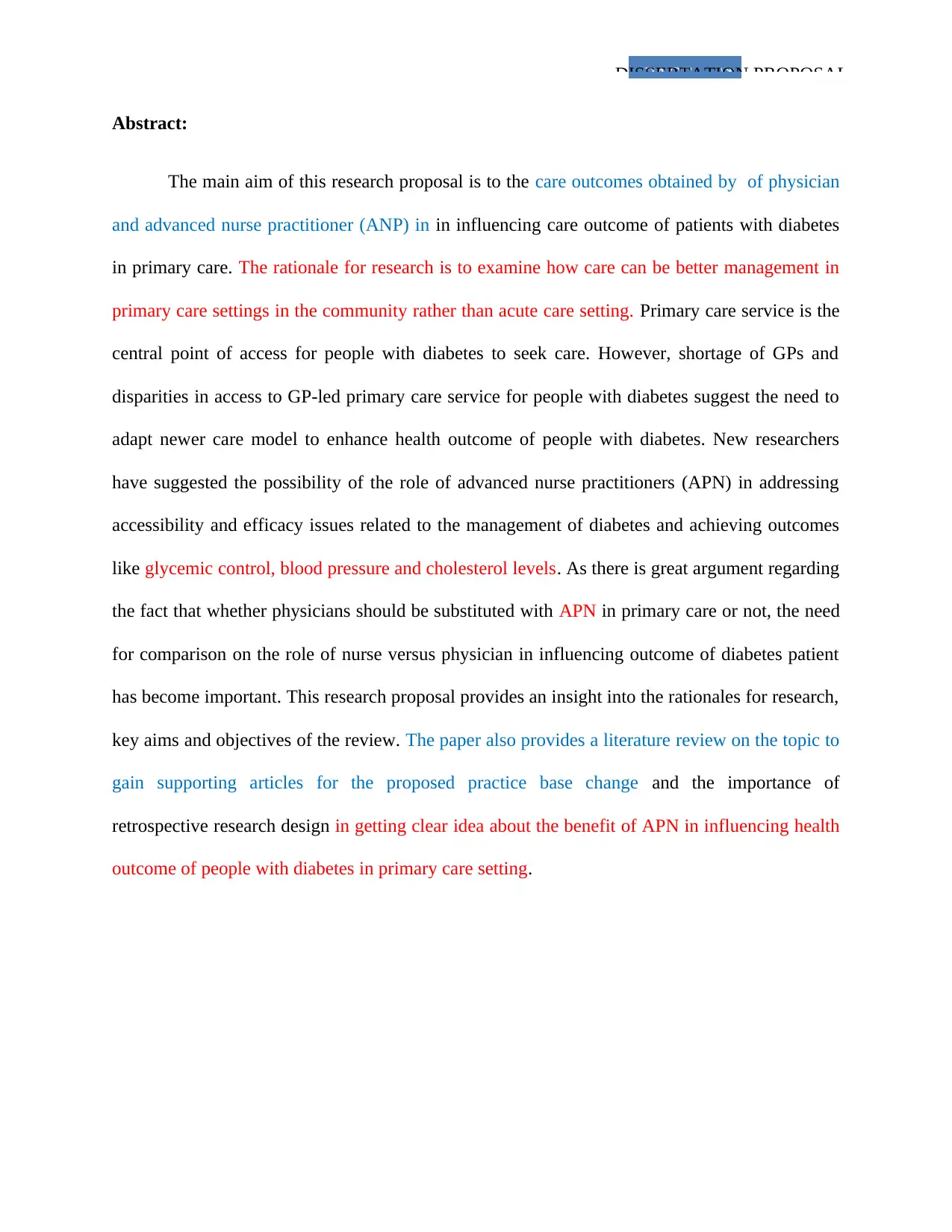
PAGE \*DISSERTATION PROPOSAL
Abstract:
The main aim of this research proposal is to the care outcomes obtained by of physician
and advanced nurse practitioner (ANP) in in influencing care outcome of patients with diabetes
in primary care. The rationale for research is to examine how care can be better management in
primary care settings in the community rather than acute care setting. Primary care service is the
central point of access for people with diabetes to seek care. However, shortage of GPs and
disparities in access to GP-led primary care service for people with diabetes suggest the need to
adapt newer care model to enhance health outcome of people with diabetes. New researchers
have suggested the possibility of the role of advanced nurse practitioners (APN) in addressing
accessibility and efficacy issues related to the management of diabetes and achieving outcomes
like glycemic control, blood pressure and cholesterol levels. As there is great argument regarding
the fact that whether physicians should be substituted with APN in primary care or not, the need
for comparison on the role of nurse versus physician in influencing outcome of diabetes patient
has become important. This research proposal provides an insight into the rationales for research,
key aims and objectives of the review. The paper also provides a literature review on the topic to
gain supporting articles for the proposed practice base change and the importance of
retrospective research design in getting clear idea about the benefit of APN in influencing health
outcome of people with diabetes in primary care setting.
Abstract:
The main aim of this research proposal is to the care outcomes obtained by of physician
and advanced nurse practitioner (ANP) in in influencing care outcome of patients with diabetes
in primary care. The rationale for research is to examine how care can be better management in
primary care settings in the community rather than acute care setting. Primary care service is the
central point of access for people with diabetes to seek care. However, shortage of GPs and
disparities in access to GP-led primary care service for people with diabetes suggest the need to
adapt newer care model to enhance health outcome of people with diabetes. New researchers
have suggested the possibility of the role of advanced nurse practitioners (APN) in addressing
accessibility and efficacy issues related to the management of diabetes and achieving outcomes
like glycemic control, blood pressure and cholesterol levels. As there is great argument regarding
the fact that whether physicians should be substituted with APN in primary care or not, the need
for comparison on the role of nurse versus physician in influencing outcome of diabetes patient
has become important. This research proposal provides an insight into the rationales for research,
key aims and objectives of the review. The paper also provides a literature review on the topic to
gain supporting articles for the proposed practice base change and the importance of
retrospective research design in getting clear idea about the benefit of APN in influencing health
outcome of people with diabetes in primary care setting.
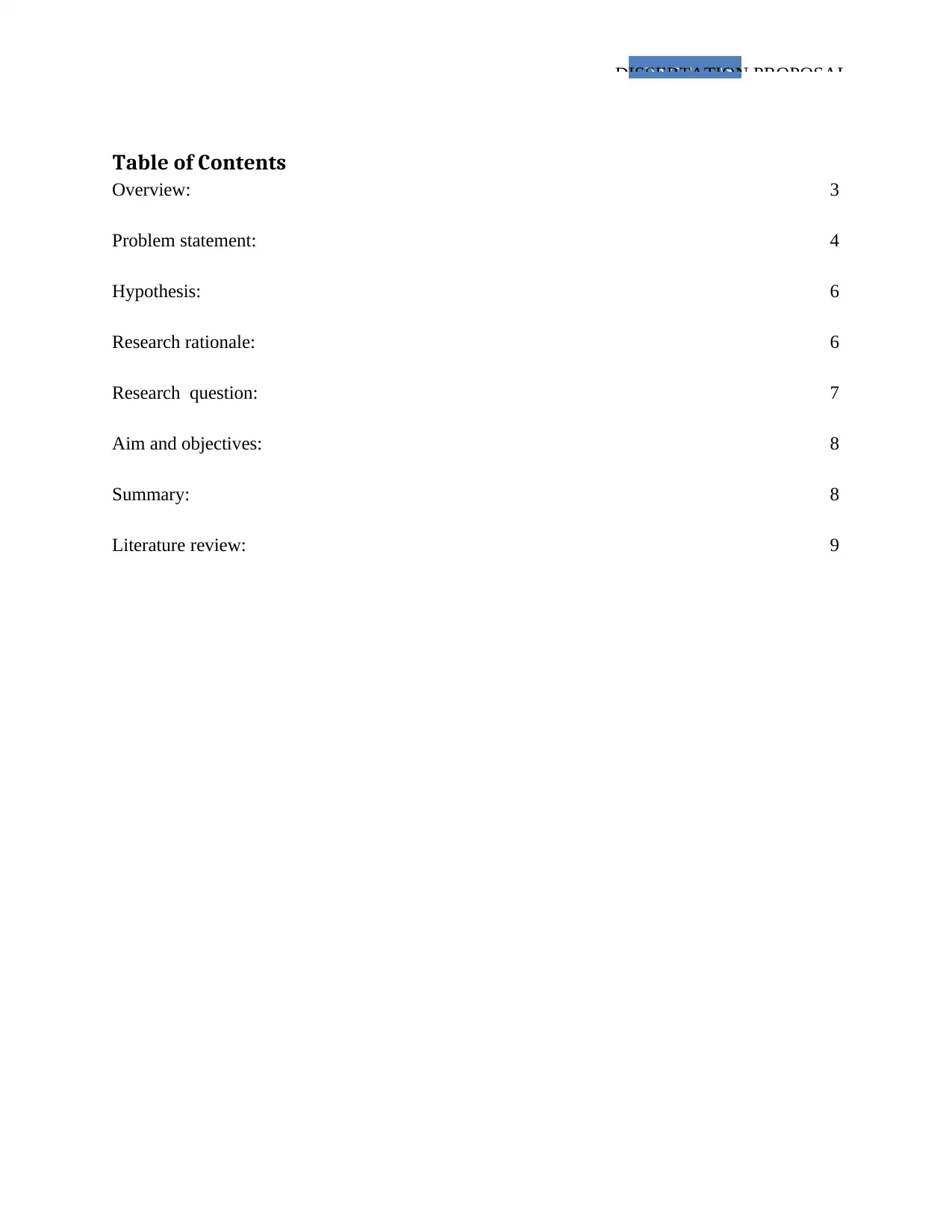
PAGE \*DISSERTATION PROPOSAL
Table of Contents
Overview: 3
Problem statement: 4
Hypothesis: 6
Research rationale: 6
Research question: 7
Aim and objectives: 8
Summary: 8
Literature review: 9
Table of Contents
Overview: 3
Problem statement: 4
Hypothesis: 6
Research rationale: 6
Research question: 7
Aim and objectives: 8
Summary: 8
Literature review: 9
⊘ This is a preview!⊘
Do you want full access?
Subscribe today to unlock all pages.

Trusted by 1+ million students worldwide
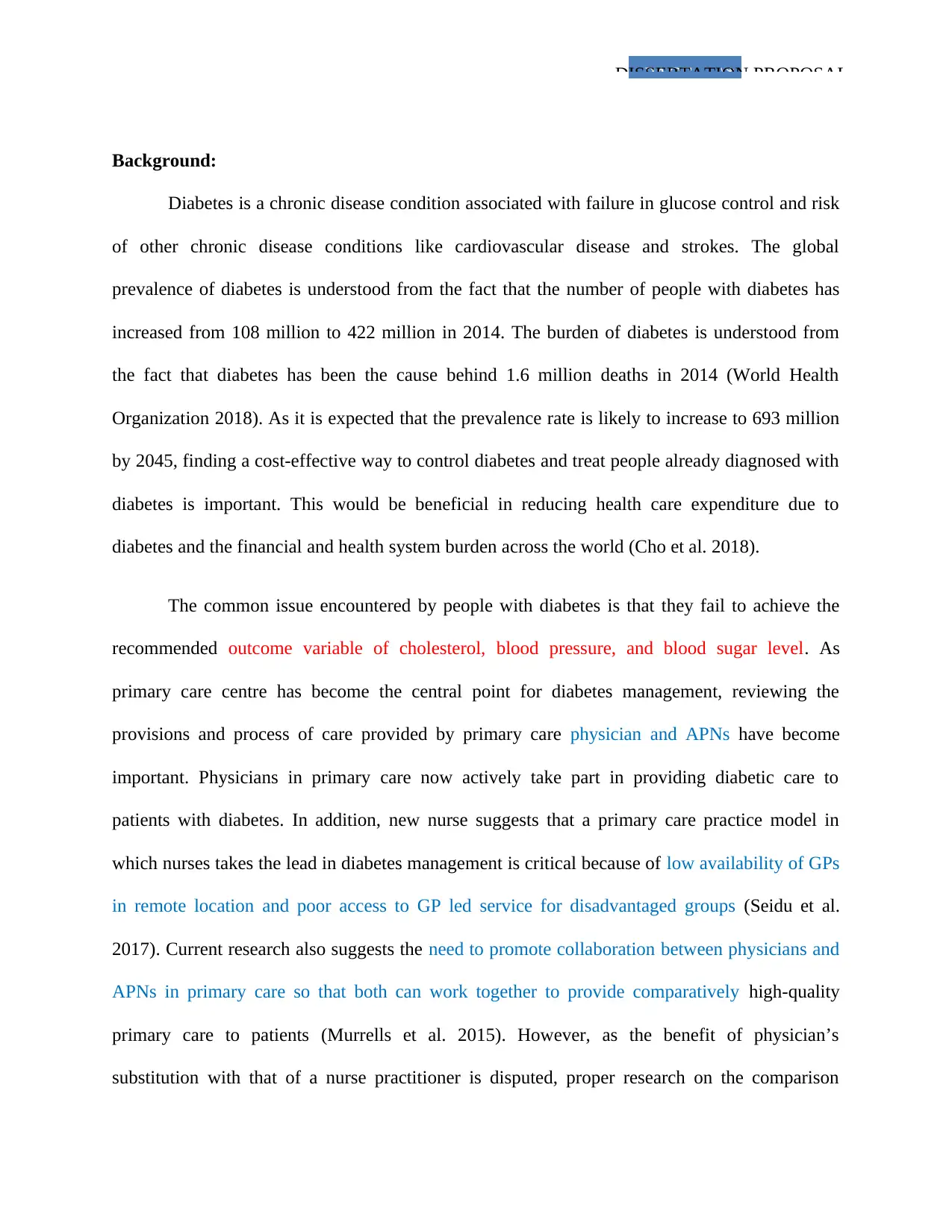
PAGE \*DISSERTATION PROPOSAL
Background:
Diabetes is a chronic disease condition associated with failure in glucose control and risk
of other chronic disease conditions like cardiovascular disease and strokes. The global
prevalence of diabetes is understood from the fact that the number of people with diabetes has
increased from 108 million to 422 million in 2014. The burden of diabetes is understood from
the fact that diabetes has been the cause behind 1.6 million deaths in 2014 (World Health
Organization 2018). As it is expected that the prevalence rate is likely to increase to 693 million
by 2045, finding a cost-effective way to control diabetes and treat people already diagnosed with
diabetes is important. This would be beneficial in reducing health care expenditure due to
diabetes and the financial and health system burden across the world (Cho et al. 2018).
The common issue encountered by people with diabetes is that they fail to achieve the
recommended outcome variable of cholesterol, blood pressure, and blood sugar level. As
primary care centre has become the central point for diabetes management, reviewing the
provisions and process of care provided by primary care physician and APNs have become
important. Physicians in primary care now actively take part in providing diabetic care to
patients with diabetes. In addition, new nurse suggests that a primary care practice model in
which nurses takes the lead in diabetes management is critical because of low availability of GPs
in remote location and poor access to GP led service for disadvantaged groups (Seidu et al.
2017). Current research also suggests the need to promote collaboration between physicians and
APNs in primary care so that both can work together to provide comparatively high-quality
primary care to patients (Murrells et al. 2015). However, as the benefit of physician’s
substitution with that of a nurse practitioner is disputed, proper research on the comparison
Background:
Diabetes is a chronic disease condition associated with failure in glucose control and risk
of other chronic disease conditions like cardiovascular disease and strokes. The global
prevalence of diabetes is understood from the fact that the number of people with diabetes has
increased from 108 million to 422 million in 2014. The burden of diabetes is understood from
the fact that diabetes has been the cause behind 1.6 million deaths in 2014 (World Health
Organization 2018). As it is expected that the prevalence rate is likely to increase to 693 million
by 2045, finding a cost-effective way to control diabetes and treat people already diagnosed with
diabetes is important. This would be beneficial in reducing health care expenditure due to
diabetes and the financial and health system burden across the world (Cho et al. 2018).
The common issue encountered by people with diabetes is that they fail to achieve the
recommended outcome variable of cholesterol, blood pressure, and blood sugar level. As
primary care centre has become the central point for diabetes management, reviewing the
provisions and process of care provided by primary care physician and APNs have become
important. Physicians in primary care now actively take part in providing diabetic care to
patients with diabetes. In addition, new nurse suggests that a primary care practice model in
which nurses takes the lead in diabetes management is critical because of low availability of GPs
in remote location and poor access to GP led service for disadvantaged groups (Seidu et al.
2017). Current research also suggests the need to promote collaboration between physicians and
APNs in primary care so that both can work together to provide comparatively high-quality
primary care to patients (Murrells et al. 2015). However, as the benefit of physician’s
substitution with that of a nurse practitioner is disputed, proper research on the comparison
Paraphrase This Document
Need a fresh take? Get an instant paraphrase of this document with our AI Paraphraser
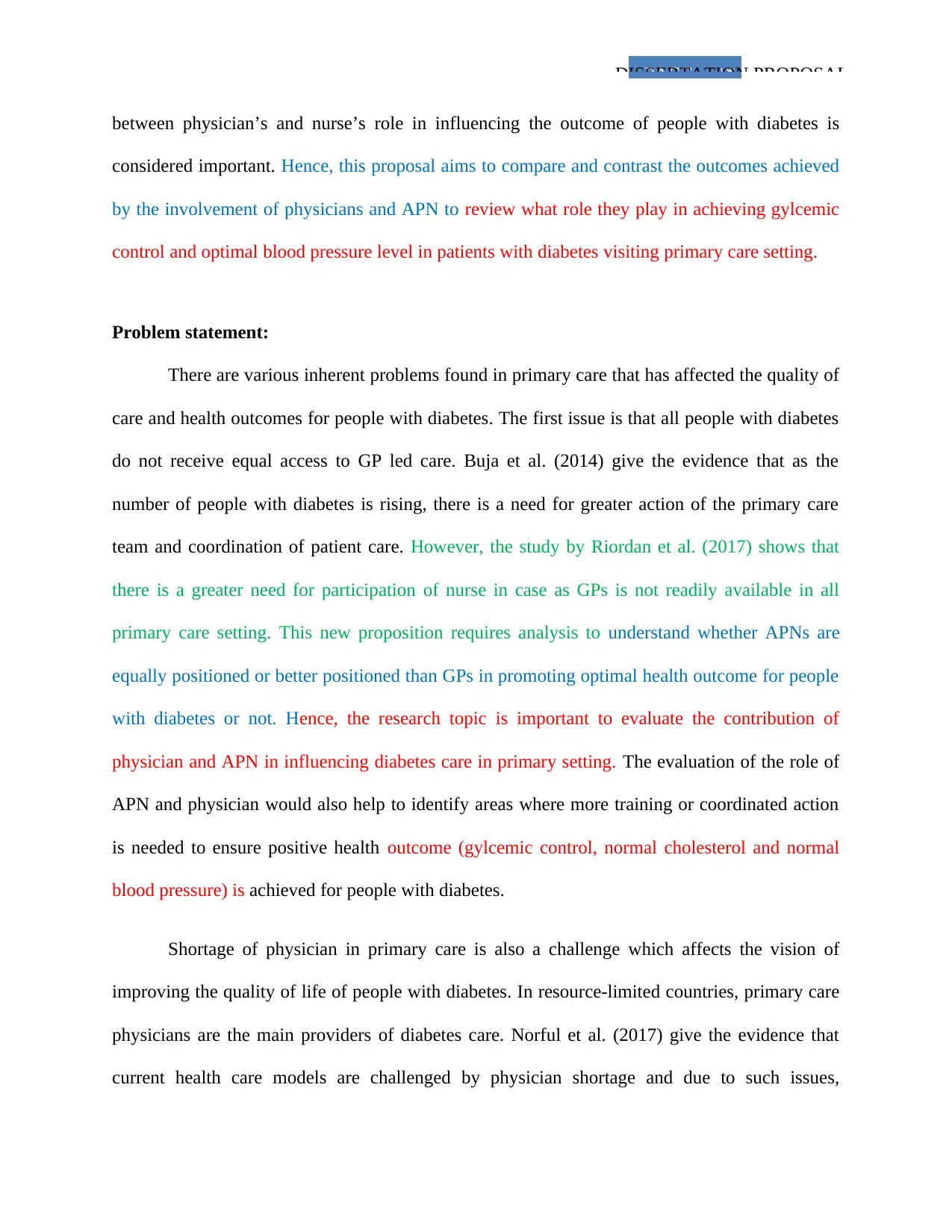
PAGE \*DISSERTATION PROPOSAL
between physician’s and nurse’s role in influencing the outcome of people with diabetes is
considered important. Hence, this proposal aims to compare and contrast the outcomes achieved
by the involvement of physicians and APN to review what role they play in achieving gylcemic
control and optimal blood pressure level in patients with diabetes visiting primary care setting.
Problem statement:
There are various inherent problems found in primary care that has affected the quality of
care and health outcomes for people with diabetes. The first issue is that all people with diabetes
do not receive equal access to GP led care. Buja et al. (2014) give the evidence that as the
number of people with diabetes is rising, there is a need for greater action of the primary care
team and coordination of patient care. However, the study by Riordan et al. (2017) shows that
there is a greater need for participation of nurse in case as GPs is not readily available in all
primary care setting. This new proposition requires analysis to understand whether APNs are
equally positioned or better positioned than GPs in promoting optimal health outcome for people
with diabetes or not. Hence, the research topic is important to evaluate the contribution of
physician and APN in influencing diabetes care in primary setting. The evaluation of the role of
APN and physician would also help to identify areas where more training or coordinated action
is needed to ensure positive health outcome (gylcemic control, normal cholesterol and normal
blood pressure) is achieved for people with diabetes.
Shortage of physician in primary care is also a challenge which affects the vision of
improving the quality of life of people with diabetes. In resource-limited countries, primary care
physicians are the main providers of diabetes care. Norful et al. (2017) give the evidence that
current health care models are challenged by physician shortage and due to such issues,
between physician’s and nurse’s role in influencing the outcome of people with diabetes is
considered important. Hence, this proposal aims to compare and contrast the outcomes achieved
by the involvement of physicians and APN to review what role they play in achieving gylcemic
control and optimal blood pressure level in patients with diabetes visiting primary care setting.
Problem statement:
There are various inherent problems found in primary care that has affected the quality of
care and health outcomes for people with diabetes. The first issue is that all people with diabetes
do not receive equal access to GP led care. Buja et al. (2014) give the evidence that as the
number of people with diabetes is rising, there is a need for greater action of the primary care
team and coordination of patient care. However, the study by Riordan et al. (2017) shows that
there is a greater need for participation of nurse in case as GPs is not readily available in all
primary care setting. This new proposition requires analysis to understand whether APNs are
equally positioned or better positioned than GPs in promoting optimal health outcome for people
with diabetes or not. Hence, the research topic is important to evaluate the contribution of
physician and APN in influencing diabetes care in primary setting. The evaluation of the role of
APN and physician would also help to identify areas where more training or coordinated action
is needed to ensure positive health outcome (gylcemic control, normal cholesterol and normal
blood pressure) is achieved for people with diabetes.
Shortage of physician in primary care is also a challenge which affects the vision of
improving the quality of life of people with diabetes. In resource-limited countries, primary care
physicians are the main providers of diabetes care. Norful et al. (2017) give the evidence that
current health care models are challenged by physician shortage and due to such issues,

PAGE \*DISSERTATION PROPOSAL
clinicians and policymakers are suggesting team-based care models. Hence, there is a possibility
can APN can become a necessary part of team based models of care. As such low-income
countries also suffer from challenges because of a shortage of specialist staff, in such scenario
primary care physicians should be highly capacitated to address the rising demand for diabetic
care. However, inconsistent practices related to diabetes diagnosis, evaluation and management
among care providers, poor utilization of primary care service by diabetes patients and limited
consultation time suggest the need to review skills and efficacy of physicians in diabetes
management again (Jingi, Nansseu and Noubiap 2015). As there is lack of research on the
aptitude of health care providers related to diabetes care, evaluating and comparing studies
related to the diabetes related outcomes achieved by physicians and APNs in treating diabetes
patient in primary care is vital. Comprehensive research and literature review will help to
understand gaps in current research related to achieving optimal gylcemic control and blood
pressure control. It will also suggest the role of retrospective chart review in comparing and
differentiating the outcome achieved for diabetes patient in primary care setting when care is
delivered by APNs and physicians.
Hypothesis:
The research hypothesis is that the advanced nurse practitioners are well equipped to
improve the health outcome of people with diabetes. This hypothesis has been made because
APNs have competencies related to direct clinical skills and they have been able to maintain
optimal glycaemic level in diabetes patient, reduce cholesterol and blood pressure in primary
care setting (Cooke, Gemmill and Grant 2008). the expectation that nurses spend more time with
people in care and they can work to individual manage challenges faced by the diabetic patient in
adhering to treatment guideline. Murrells et al. (2015) give the evidence that specialist nurse is
clinicians and policymakers are suggesting team-based care models. Hence, there is a possibility
can APN can become a necessary part of team based models of care. As such low-income
countries also suffer from challenges because of a shortage of specialist staff, in such scenario
primary care physicians should be highly capacitated to address the rising demand for diabetic
care. However, inconsistent practices related to diabetes diagnosis, evaluation and management
among care providers, poor utilization of primary care service by diabetes patients and limited
consultation time suggest the need to review skills and efficacy of physicians in diabetes
management again (Jingi, Nansseu and Noubiap 2015). As there is lack of research on the
aptitude of health care providers related to diabetes care, evaluating and comparing studies
related to the diabetes related outcomes achieved by physicians and APNs in treating diabetes
patient in primary care is vital. Comprehensive research and literature review will help to
understand gaps in current research related to achieving optimal gylcemic control and blood
pressure control. It will also suggest the role of retrospective chart review in comparing and
differentiating the outcome achieved for diabetes patient in primary care setting when care is
delivered by APNs and physicians.
Hypothesis:
The research hypothesis is that the advanced nurse practitioners are well equipped to
improve the health outcome of people with diabetes. This hypothesis has been made because
APNs have competencies related to direct clinical skills and they have been able to maintain
optimal glycaemic level in diabetes patient, reduce cholesterol and blood pressure in primary
care setting (Cooke, Gemmill and Grant 2008). the expectation that nurses spend more time with
people in care and they can work to individual manage challenges faced by the diabetic patient in
adhering to treatment guideline. Murrells et al. (2015) give the evidence that specialist nurse is
⊘ This is a preview!⊘
Do you want full access?
Subscribe today to unlock all pages.

Trusted by 1+ million students worldwide
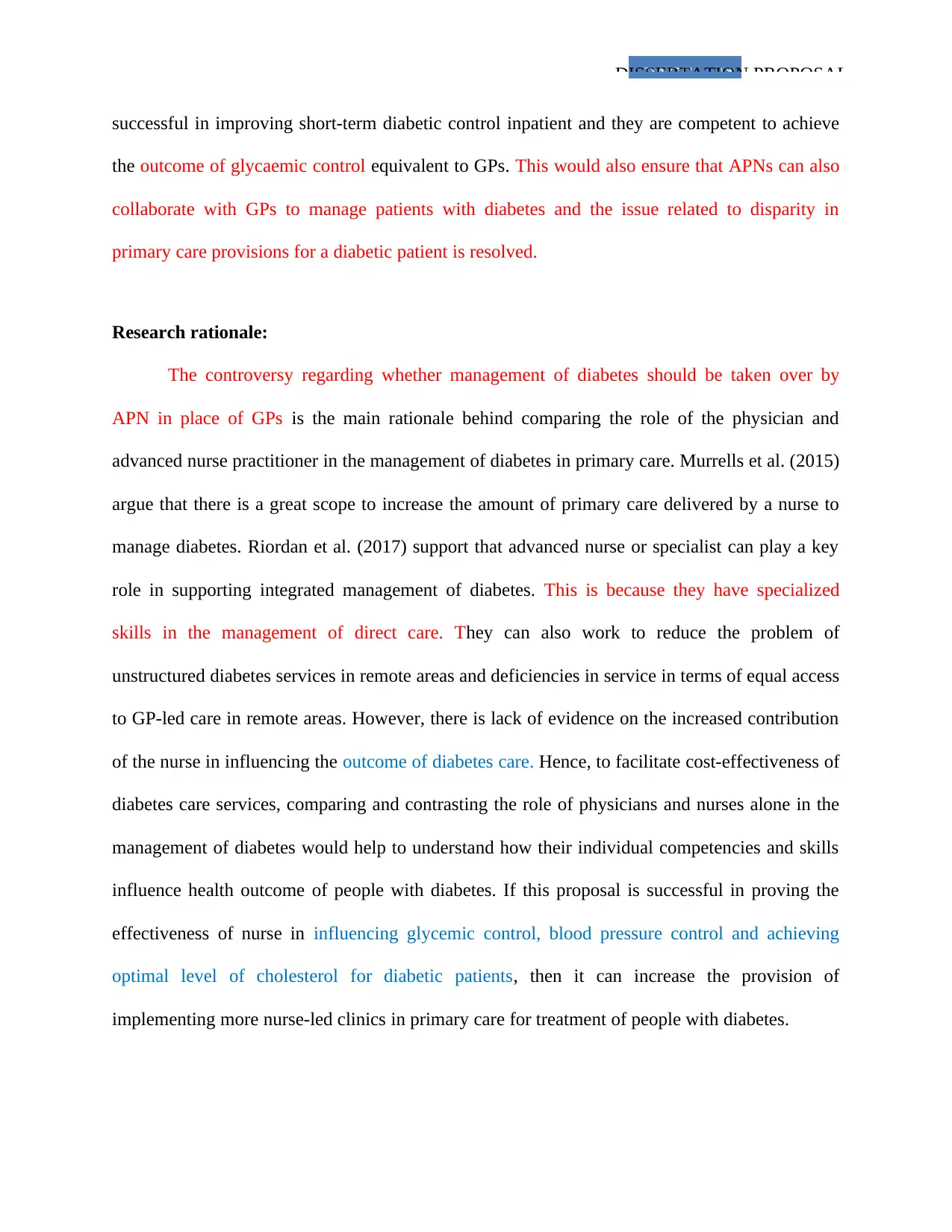
PAGE \*DISSERTATION PROPOSAL
successful in improving short-term diabetic control inpatient and they are competent to achieve
the outcome of glycaemic control equivalent to GPs. This would also ensure that APNs can also
collaborate with GPs to manage patients with diabetes and the issue related to disparity in
primary care provisions for a diabetic patient is resolved.
Research rationale:
The controversy regarding whether management of diabetes should be taken over by
APN in place of GPs is the main rationale behind comparing the role of the physician and
advanced nurse practitioner in the management of diabetes in primary care. Murrells et al. (2015)
argue that there is a great scope to increase the amount of primary care delivered by a nurse to
manage diabetes. Riordan et al. (2017) support that advanced nurse or specialist can play a key
role in supporting integrated management of diabetes. This is because they have specialized
skills in the management of direct care. They can also work to reduce the problem of
unstructured diabetes services in remote areas and deficiencies in service in terms of equal access
to GP-led care in remote areas. However, there is lack of evidence on the increased contribution
of the nurse in influencing the outcome of diabetes care. Hence, to facilitate cost-effectiveness of
diabetes care services, comparing and contrasting the role of physicians and nurses alone in the
management of diabetes would help to understand how their individual competencies and skills
influence health outcome of people with diabetes. If this proposal is successful in proving the
effectiveness of nurse in influencing glycemic control, blood pressure control and achieving
optimal level of cholesterol for diabetic patients, then it can increase the provision of
implementing more nurse-led clinics in primary care for treatment of people with diabetes.
successful in improving short-term diabetic control inpatient and they are competent to achieve
the outcome of glycaemic control equivalent to GPs. This would also ensure that APNs can also
collaborate with GPs to manage patients with diabetes and the issue related to disparity in
primary care provisions for a diabetic patient is resolved.
Research rationale:
The controversy regarding whether management of diabetes should be taken over by
APN in place of GPs is the main rationale behind comparing the role of the physician and
advanced nurse practitioner in the management of diabetes in primary care. Murrells et al. (2015)
argue that there is a great scope to increase the amount of primary care delivered by a nurse to
manage diabetes. Riordan et al. (2017) support that advanced nurse or specialist can play a key
role in supporting integrated management of diabetes. This is because they have specialized
skills in the management of direct care. They can also work to reduce the problem of
unstructured diabetes services in remote areas and deficiencies in service in terms of equal access
to GP-led care in remote areas. However, there is lack of evidence on the increased contribution
of the nurse in influencing the outcome of diabetes care. Hence, to facilitate cost-effectiveness of
diabetes care services, comparing and contrasting the role of physicians and nurses alone in the
management of diabetes would help to understand how their individual competencies and skills
influence health outcome of people with diabetes. If this proposal is successful in proving the
effectiveness of nurse in influencing glycemic control, blood pressure control and achieving
optimal level of cholesterol for diabetic patients, then it can increase the provision of
implementing more nurse-led clinics in primary care for treatment of people with diabetes.
Paraphrase This Document
Need a fresh take? Get an instant paraphrase of this document with our AI Paraphraser

PAGE \*DISSERTATION PROPOSAL
The significance of researching on the topic is also understood from the disparities
between physician availability in rural and urban areas and rise in health care cost. Kuo et al.
(2015) revealed mixed results on the quality of care delivered by nurse practitioners (NP) and
physicians. On the one hand, a systematic review revealed the benefit of NP in lowering
hospitalization rate for people with diabetes. However, conflicting findings on the cost of care
were achieved. Another paper by Azam et al. (2018) showed no statistically significant
difference in HbA1c level and blood pressure after inclusion of NP in primary care. As an
adequate number of primary care physicians are not available in remote regions, this research
would help to develop the understanding whether inclusion of advanced practice nurse would be
a cost-effective approach to improve the health of the diabetic patient or not.
Research question:
The PICOT question related to the topic are as follows:
‘What is the value of advanced nurse practitioner (ANP) and physicians in managing the chronic
disease diabetes in primary care?
The research population is people with diabetes and the main comparison is between and
outcomes achieved by APNs and physicians in achieving optimal diabetes related outcome s in
primary care. The outcome of interest in this research proposal is gylcaemic control, blood
pressure control and normal cholesterol levels.
Aim and objectives:
The main aim of this research proposal is to compare and contrast the achievement of
gylcaemic control and blood pressure control related outcomes for ANP and physician while
The significance of researching on the topic is also understood from the disparities
between physician availability in rural and urban areas and rise in health care cost. Kuo et al.
(2015) revealed mixed results on the quality of care delivered by nurse practitioners (NP) and
physicians. On the one hand, a systematic review revealed the benefit of NP in lowering
hospitalization rate for people with diabetes. However, conflicting findings on the cost of care
were achieved. Another paper by Azam et al. (2018) showed no statistically significant
difference in HbA1c level and blood pressure after inclusion of NP in primary care. As an
adequate number of primary care physicians are not available in remote regions, this research
would help to develop the understanding whether inclusion of advanced practice nurse would be
a cost-effective approach to improve the health of the diabetic patient or not.
Research question:
The PICOT question related to the topic are as follows:
‘What is the value of advanced nurse practitioner (ANP) and physicians in managing the chronic
disease diabetes in primary care?
The research population is people with diabetes and the main comparison is between and
outcomes achieved by APNs and physicians in achieving optimal diabetes related outcome s in
primary care. The outcome of interest in this research proposal is gylcaemic control, blood
pressure control and normal cholesterol levels.
Aim and objectives:
The main aim of this research proposal is to compare and contrast the achievement of
gylcaemic control and blood pressure control related outcomes for ANP and physician while
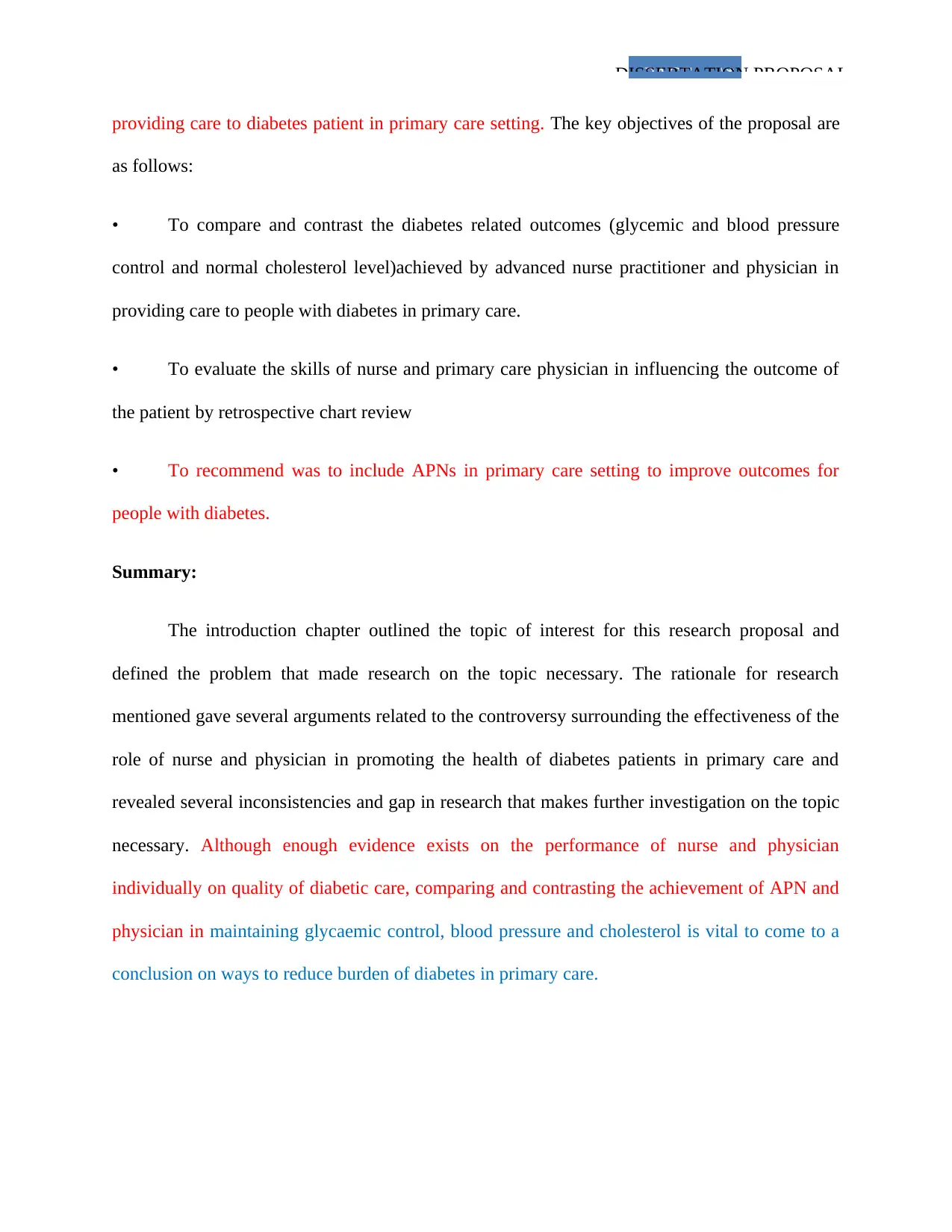
PAGE \*DISSERTATION PROPOSAL
providing care to diabetes patient in primary care setting. The key objectives of the proposal are
as follows:
• To compare and contrast the diabetes related outcomes (glycemic and blood pressure
control and normal cholesterol level)achieved by advanced nurse practitioner and physician in
providing care to people with diabetes in primary care.
• To evaluate the skills of nurse and primary care physician in influencing the outcome of
the patient by retrospective chart review
• To recommend was to include APNs in primary care setting to improve outcomes for
people with diabetes.
Summary:
The introduction chapter outlined the topic of interest for this research proposal and
defined the problem that made research on the topic necessary. The rationale for research
mentioned gave several arguments related to the controversy surrounding the effectiveness of the
role of nurse and physician in promoting the health of diabetes patients in primary care and
revealed several inconsistencies and gap in research that makes further investigation on the topic
necessary. Although enough evidence exists on the performance of nurse and physician
individually on quality of diabetic care, comparing and contrasting the achievement of APN and
physician in maintaining glycaemic control, blood pressure and cholesterol is vital to come to a
conclusion on ways to reduce burden of diabetes in primary care.
providing care to diabetes patient in primary care setting. The key objectives of the proposal are
as follows:
• To compare and contrast the diabetes related outcomes (glycemic and blood pressure
control and normal cholesterol level)achieved by advanced nurse practitioner and physician in
providing care to people with diabetes in primary care.
• To evaluate the skills of nurse and primary care physician in influencing the outcome of
the patient by retrospective chart review
• To recommend was to include APNs in primary care setting to improve outcomes for
people with diabetes.
Summary:
The introduction chapter outlined the topic of interest for this research proposal and
defined the problem that made research on the topic necessary. The rationale for research
mentioned gave several arguments related to the controversy surrounding the effectiveness of the
role of nurse and physician in promoting the health of diabetes patients in primary care and
revealed several inconsistencies and gap in research that makes further investigation on the topic
necessary. Although enough evidence exists on the performance of nurse and physician
individually on quality of diabetic care, comparing and contrasting the achievement of APN and
physician in maintaining glycaemic control, blood pressure and cholesterol is vital to come to a
conclusion on ways to reduce burden of diabetes in primary care.
⊘ This is a preview!⊘
Do you want full access?
Subscribe today to unlock all pages.

Trusted by 1+ million students worldwide
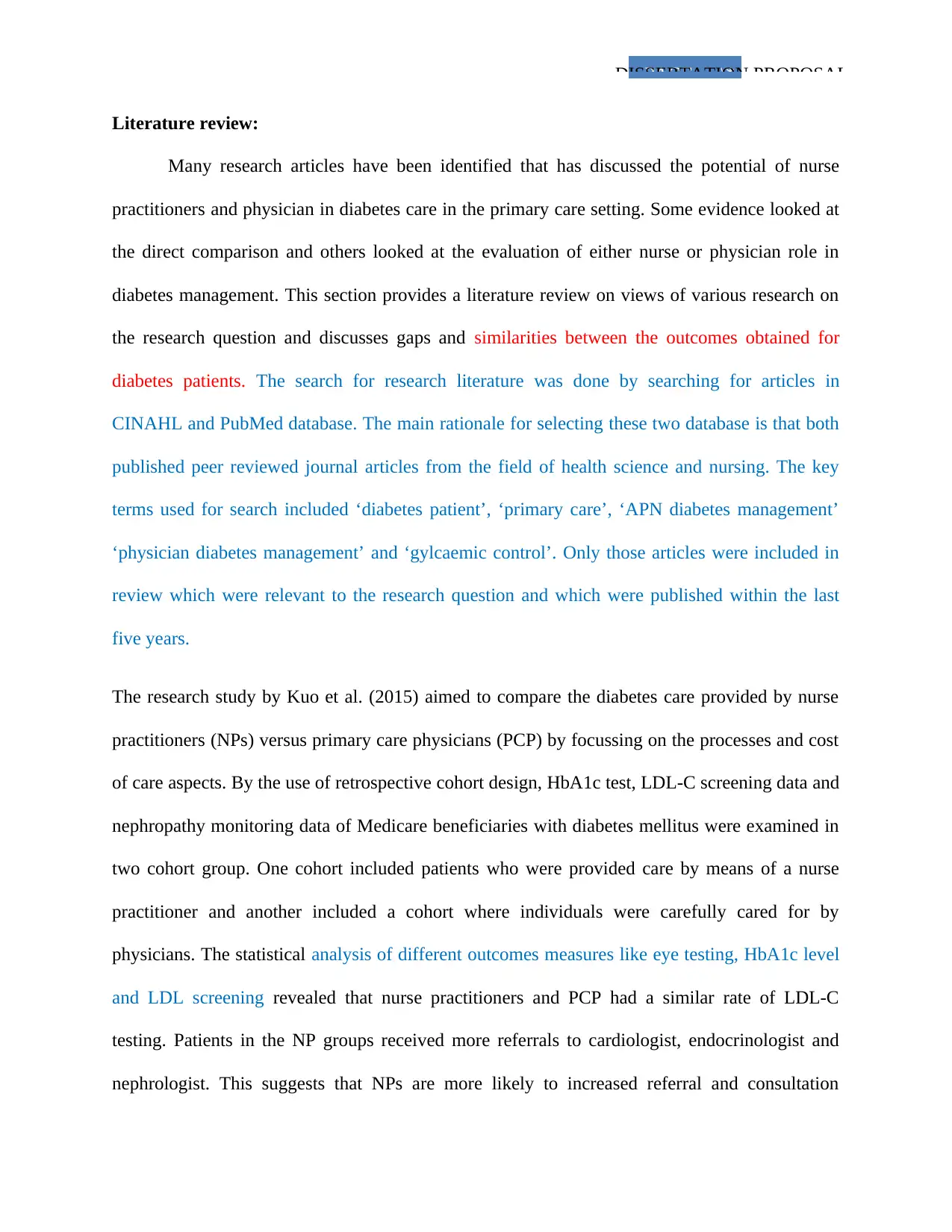
PAGE \*DISSERTATION PROPOSAL
Literature review:
Many research articles have been identified that has discussed the potential of nurse
practitioners and physician in diabetes care in the primary care setting. Some evidence looked at
the direct comparison and others looked at the evaluation of either nurse or physician role in
diabetes management. This section provides a literature review on views of various research on
the research question and discusses gaps and similarities between the outcomes obtained for
diabetes patients. The search for research literature was done by searching for articles in
CINAHL and PubMed database. The main rationale for selecting these two database is that both
published peer reviewed journal articles from the field of health science and nursing. The key
terms used for search included ‘diabetes patient’, ‘primary care’, ‘APN diabetes management’
‘physician diabetes management’ and ‘gylcaemic control’. Only those articles were included in
review which were relevant to the research question and which were published within the last
five years.
The research study by Kuo et al. (2015) aimed to compare the diabetes care provided by nurse
practitioners (NPs) versus primary care physicians (PCP) by focussing on the processes and cost
of care aspects. By the use of retrospective cohort design, HbA1c test, LDL-C screening data and
nephropathy monitoring data of Medicare beneficiaries with diabetes mellitus were examined in
two cohort group. One cohort included patients who were provided care by means of a nurse
practitioner and another included a cohort where individuals were carefully cared for by
physicians. The statistical analysis of different outcomes measures like eye testing, HbA1c level
and LDL screening revealed that nurse practitioners and PCP had a similar rate of LDL-C
testing. Patients in the NP groups received more referrals to cardiologist, endocrinologist and
nephrologist. This suggests that NPs are more likely to increased referral and consultation
Literature review:
Many research articles have been identified that has discussed the potential of nurse
practitioners and physician in diabetes care in the primary care setting. Some evidence looked at
the direct comparison and others looked at the evaluation of either nurse or physician role in
diabetes management. This section provides a literature review on views of various research on
the research question and discusses gaps and similarities between the outcomes obtained for
diabetes patients. The search for research literature was done by searching for articles in
CINAHL and PubMed database. The main rationale for selecting these two database is that both
published peer reviewed journal articles from the field of health science and nursing. The key
terms used for search included ‘diabetes patient’, ‘primary care’, ‘APN diabetes management’
‘physician diabetes management’ and ‘gylcaemic control’. Only those articles were included in
review which were relevant to the research question and which were published within the last
five years.
The research study by Kuo et al. (2015) aimed to compare the diabetes care provided by nurse
practitioners (NPs) versus primary care physicians (PCP) by focussing on the processes and cost
of care aspects. By the use of retrospective cohort design, HbA1c test, LDL-C screening data and
nephropathy monitoring data of Medicare beneficiaries with diabetes mellitus were examined in
two cohort group. One cohort included patients who were provided care by means of a nurse
practitioner and another included a cohort where individuals were carefully cared for by
physicians. The statistical analysis of different outcomes measures like eye testing, HbA1c level
and LDL screening revealed that nurse practitioners and PCP had a similar rate of LDL-C
testing. Patients in the NP groups received more referrals to cardiologist, endocrinologist and
nephrologist. This suggests that NPs are more likely to increased referral and consultation
Paraphrase This Document
Need a fresh take? Get an instant paraphrase of this document with our AI Paraphraser
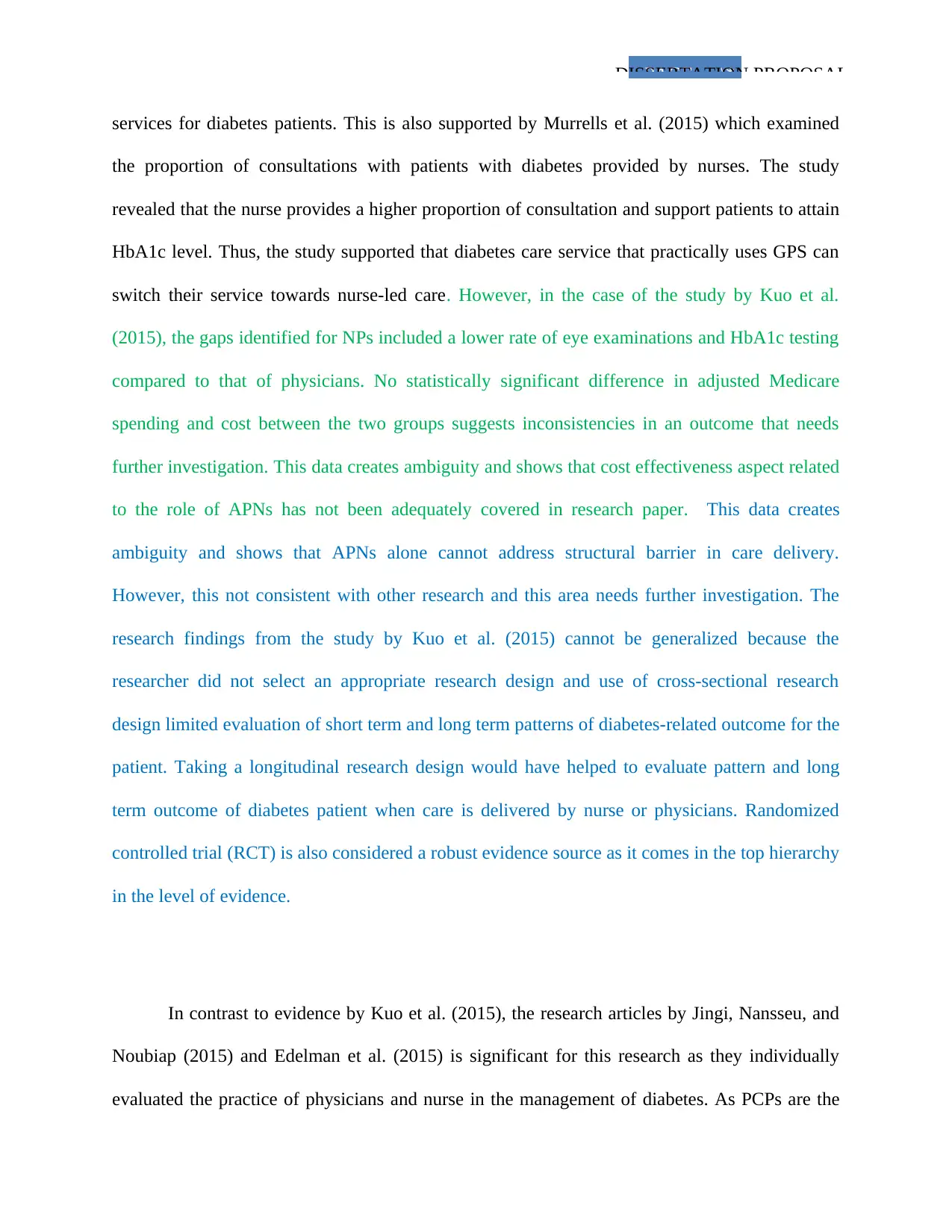
PAGE \*DISSERTATION PROPOSAL
services for diabetes patients. This is also supported by Murrells et al. (2015) which examined
the proportion of consultations with patients with diabetes provided by nurses. The study
revealed that the nurse provides a higher proportion of consultation and support patients to attain
HbA1c level. Thus, the study supported that diabetes care service that practically uses GPS can
switch their service towards nurse-led care. However, in the case of the study by Kuo et al.
(2015), the gaps identified for NPs included a lower rate of eye examinations and HbA1c testing
compared to that of physicians. No statistically significant difference in adjusted Medicare
spending and cost between the two groups suggests inconsistencies in an outcome that needs
further investigation. This data creates ambiguity and shows that cost effectiveness aspect related
to the role of APNs has not been adequately covered in research paper. This data creates
ambiguity and shows that APNs alone cannot address structural barrier in care delivery.
However, this not consistent with other research and this area needs further investigation. The
research findings from the study by Kuo et al. (2015) cannot be generalized because the
researcher did not select an appropriate research design and use of cross-sectional research
design limited evaluation of short term and long term patterns of diabetes-related outcome for the
patient. Taking a longitudinal research design would have helped to evaluate pattern and long
term outcome of diabetes patient when care is delivered by nurse or physicians. Randomized
controlled trial (RCT) is also considered a robust evidence source as it comes in the top hierarchy
in the level of evidence.
In contrast to evidence by Kuo et al. (2015), the research articles by Jingi, Nansseu, and
Noubiap (2015) and Edelman et al. (2015) is significant for this research as they individually
evaluated the practice of physicians and nurse in the management of diabetes. As PCPs are the
services for diabetes patients. This is also supported by Murrells et al. (2015) which examined
the proportion of consultations with patients with diabetes provided by nurses. The study
revealed that the nurse provides a higher proportion of consultation and support patients to attain
HbA1c level. Thus, the study supported that diabetes care service that practically uses GPS can
switch their service towards nurse-led care. However, in the case of the study by Kuo et al.
(2015), the gaps identified for NPs included a lower rate of eye examinations and HbA1c testing
compared to that of physicians. No statistically significant difference in adjusted Medicare
spending and cost between the two groups suggests inconsistencies in an outcome that needs
further investigation. This data creates ambiguity and shows that cost effectiveness aspect related
to the role of APNs has not been adequately covered in research paper. This data creates
ambiguity and shows that APNs alone cannot address structural barrier in care delivery.
However, this not consistent with other research and this area needs further investigation. The
research findings from the study by Kuo et al. (2015) cannot be generalized because the
researcher did not select an appropriate research design and use of cross-sectional research
design limited evaluation of short term and long term patterns of diabetes-related outcome for the
patient. Taking a longitudinal research design would have helped to evaluate pattern and long
term outcome of diabetes patient when care is delivered by nurse or physicians. Randomized
controlled trial (RCT) is also considered a robust evidence source as it comes in the top hierarchy
in the level of evidence.
In contrast to evidence by Kuo et al. (2015), the research articles by Jingi, Nansseu, and
Noubiap (2015) and Edelman et al. (2015) is significant for this research as they individually
evaluated the practice of physicians and nurse in the management of diabetes. As PCPs are the

PAGE \*DISSERTATION PROPOSAL
main staffs providing diabetes care in resource-limited regions, Jingi, Nansseu, and Noubiap
(2015) investigated about the approach used by PCP ’s in the diagnosis and management of
diabetes in Cameroon. The cross-sectional survey with PCPs investigated physicians knowledge
related to PM diagnosis, diabetes-related advice, and types of drugs provided to patients with
diabetes. The study revealed inefficiencies of the PCPs in completing physical examination for
diabetes. There were at least 36.4% of the respondents who did not perform a complete physical
examination for patients with diabetes. However, at least 77.3% constantly seeking information
on new and current guidelines related to diabetes care. Following update, guidelines are relevant
to the value of evidence-based practice in the clinical setting today. Norful et al. (2017)
supported that the new model of care is needed to increase adherence to recommended clinical
guidelines for primary care staffs. Despite this, the lack of completeness of physical examination
suggests that duration of practice is a significant factor that influenced this aspect of skills for
PCPs. The findings give implication for regular training of staffs to influence their ability to
provided optimal diabetes care. However, the study is not relevant to the purpose of investigation
for this research proposal as it did not include the outcome of diabetes patients in data analysis
and only knowledge level of PCPs was evaluated and APNs were not part of the analysis. This
study indicates that knowledge level of PCPs and APNs have not been compared in past research
thus giving insight into future research design. This is also important to take a decision on the
argument that nurse-led primary clinic or physician-led diabetes care is the key to reducing
burden and health outcome of diabetes patients.
The research findings from the study by Kuo et al. (2015) cannot be generalized because
the researcher did not select an appropriate research design and use of cross-sectional research
design limited evaluation of short term and long term patterns of diabetes-related outcome for the
main staffs providing diabetes care in resource-limited regions, Jingi, Nansseu, and Noubiap
(2015) investigated about the approach used by PCP ’s in the diagnosis and management of
diabetes in Cameroon. The cross-sectional survey with PCPs investigated physicians knowledge
related to PM diagnosis, diabetes-related advice, and types of drugs provided to patients with
diabetes. The study revealed inefficiencies of the PCPs in completing physical examination for
diabetes. There were at least 36.4% of the respondents who did not perform a complete physical
examination for patients with diabetes. However, at least 77.3% constantly seeking information
on new and current guidelines related to diabetes care. Following update, guidelines are relevant
to the value of evidence-based practice in the clinical setting today. Norful et al. (2017)
supported that the new model of care is needed to increase adherence to recommended clinical
guidelines for primary care staffs. Despite this, the lack of completeness of physical examination
suggests that duration of practice is a significant factor that influenced this aspect of skills for
PCPs. The findings give implication for regular training of staffs to influence their ability to
provided optimal diabetes care. However, the study is not relevant to the purpose of investigation
for this research proposal as it did not include the outcome of diabetes patients in data analysis
and only knowledge level of PCPs was evaluated and APNs were not part of the analysis. This
study indicates that knowledge level of PCPs and APNs have not been compared in past research
thus giving insight into future research design. This is also important to take a decision on the
argument that nurse-led primary clinic or physician-led diabetes care is the key to reducing
burden and health outcome of diabetes patients.
The research findings from the study by Kuo et al. (2015) cannot be generalized because
the researcher did not select an appropriate research design and use of cross-sectional research
design limited evaluation of short term and long term patterns of diabetes-related outcome for the
⊘ This is a preview!⊘
Do you want full access?
Subscribe today to unlock all pages.

Trusted by 1+ million students worldwide
1 out of 21
Related Documents
Your All-in-One AI-Powered Toolkit for Academic Success.
+13062052269
info@desklib.com
Available 24*7 on WhatsApp / Email
![[object Object]](/_next/static/media/star-bottom.7253800d.svg)
Unlock your academic potential
Copyright © 2020–2025 A2Z Services. All Rights Reserved. Developed and managed by ZUCOL.




